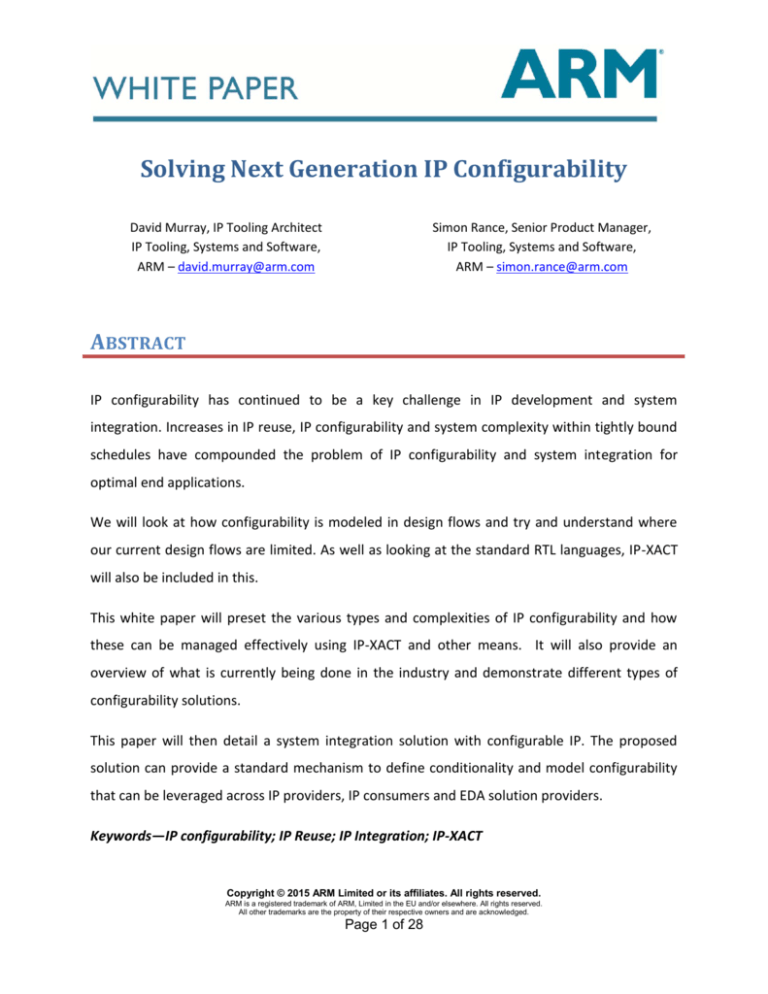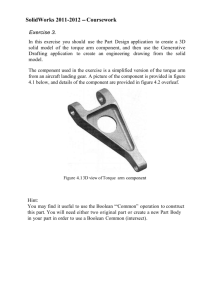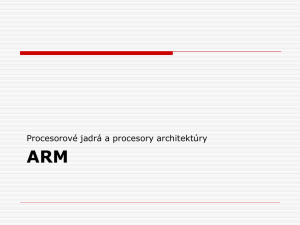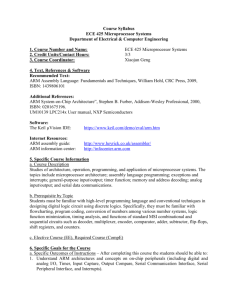
Solving Next Generation IP Configurability
David Murray, IP Tooling Architect
IP Tooling, Systems and Software,
ARM – david.murray@arm.com
Simon Rance, Senior Product Manager,
IP Tooling, Systems and Software,
ARM – simon.rance@arm.com
ABSTRACT
IP configurability has continued to be a key challenge in IP development and system
integration. Increases in IP reuse, IP configurability and system complexity within tightly bound
schedules have compounded the problem of IP configurability and system integration for
optimal end applications.
We will look at how configurability is modeled in design flows and try and understand where
our current design flows are limited. As well as looking at the standard RTL languages, IP-XACT
will also be included in this.
This white paper will preset the various types and complexities of IP configurability and how
these can be managed effectively using IP-XACT and other means. It will also provide an
overview of what is currently being done in the industry and demonstrate different types of
configurability solutions.
This paper will then detail a system integration solution with configurable IP. The proposed
solution can provide a standard mechanism to define conditionality and model configurability
that can be leveraged across IP providers, IP consumers and EDA solution providers.
Keywords—IP configurability; IP Reuse; IP Integration; IP-XACT
Copyright © 2015 ARM Limited or its affiliates. All rights reserved.
ARM is a registered trademark of ARM, Limited in the EU and/or elsewhere. All rights reserved.
All other trademarks are the property of their respective owners and are acknowledged.
Page 1 of 28
INTRODUCTION
IP configurability is evolving due to today’s highly complex systems and competitive IP market.
IP providers have to deliver reasonable cost, high quality and highly configurable IP to meet
various end applications. This poses a unique challenge to the IP provider because they need to
create and deliver IP without knowing how that IP will be integrated and configured in the IP
consumers system. The IP needs to be highly configurable to suit a wide variety of end
applications.
The SoC revolution that is driving the mobile electronics market and enabling the various
lifestyle trends, is being enabled by the adoption and integration of many complex and highly
configurable semiconductor IP’s. Where would we be without the commercial IP market?
Certainly our computing devices wouldn’t be so compact, mobile and multifunctional and our
home devices and appliances certainly wouldn’t be controllable from our phones. The adoption
and integration of commercial IP reduces the cost and time-to-market of SoCs while
dramatically raising the bar of innovation versus the competition.
The configurability of semiconductor IP continues to be a key challenge in IP development and
is quickly becoming not just a hardware and software design challenge, but also a challenge for
verification. Verifying all the combinations of IP configurations is a very challenging task for not
only the IP provider, but also the IP consumer.
Yesterday’s IP configurability challenges comprised of offering simple RTL configurability for
hardware design using ifdef parameters; although these challenges were not that long ago,
they seem so distant compared with today’s challenges comprising of a high level of intricate
configurability on both the hardware and software sides.
Copyright © 2015 ARM Limited or its affiliates. All rights reserved.
ARM is a registered trademark of ARM, Limited in the EU and/or elsewhere. All rights reserved.
All other trademarks are the property of their respective owners and are acknowledged.
Page 2 of 28
As IP adoption and reuse become more mainstream in SoC realization, IP configurability is
increasingly seen as a key challenge in enabling various next generation end applications using
the same IP. There are many IP configuration challenges.
Industry standards do not cover the full scope of IP configurability that is needed
Parameterization complexity goes well beyond industry standards like IP-XACT
Configurability is becoming IP specific
IP’s are becoming more complex and configurable and can have thousands of ports and
hundreds of different configurations.
Detailed documentation is required to describe the IP configurability so that the IP
consumer can optimally configure the IP and integrate into the end application
The poor adoption of standards and methodologies for IP configurability is making efficient
and reusable integration more difficult.
The result is a poor quality IP integration process that has been identified as one of the main
chip design challenges. A solution is needed that provides a balance between abstraction and
automation while enabling IP configurability, IP quality, and predictable IP integration.
Copyright © 2015 ARM Limited or its affiliates. All rights reserved.
ARM is a registered trademark of ARM, Limited in the EU and/or elsewhere. All rights reserved.
All other trademarks are the property of their respective owners and are acknowledged.
Page 3 of 28
WHAT IS CONFIGURABLE IP?
A static or fixed IP is an IP that has static Hardware interface and design. There are no
configurability options. The IP interface and logic are fixed and not parameterizable. It can be
used ‘off-the-shelf’ and is not dependent on any other part of the system. An example of static
IP would be a simple UART interface with no configurability. A configurable IP is an IP that can
have different configuration options. These options can be a range of different complexity from
simple configurable port widths to configurations of different internal logic, hardware interface
and HW/SW interface. From an IP delivery perspective the configurability options can have a
dramatic effect on the IP testbench and test environment, documentation, software drivers and
physical constraints. In summary adding configurability to an IP can have a dramatic effect on
the development complexity of the IP.
Examples of configurable IP
One example of configurable IP would be the DMC400 from ARM. As defined in DMC400 r2p1
TRM [2], this system has:
A configurable number of ACE-Lite interfaces (1,2 or 4)
A configurable number of memory channels (1 or 2)
However, each of these interfaces are themselves configurable. For instance each ACE-Lite
interface has the following configuration options:
Data bus width (64, 128, 256 bit)
Address bus width (32, 40, 64 bit)
ID bus width (4-24 bit)
Read burst acceptance capability (16, 32, 64)
Read hazard acceptance capability (8, 16)
Copyright © 2015 ARM Limited or its affiliates. All rights reserved.
ARM is a registered trademark of ARM, Limited in the EU and/or elsewhere. All rights reserved.
All other trademarks are the property of their respective owners and are acknowledged.
Page 4 of 28
Read hazard buffer implementation (RAM or synthesized registers)
Virtual Network existence (true/false)
And for each one of the memory interfaces, the following are configurable.
Read queue depth (16, 32, 64 bursts)
Write buffer depth (16, 32, 64 bursts)
Write buffer implementation (e.g. RAM, or synthesized registers)
Number of chip selects (1, 2)
DFI data width (32, 64, 128)
Maximum DFI burst length (4, 8)
Enable or disable memory SECDED (true/false)
Similarly Xilinx provide a PCI express v2.2 as an Integrated Block for use with Xilinx Zynq®-7000
All Programmable SoC, and 7 series FPGA families.[3] This PCI express IP Supports 1-lane, 2lane, 4-lane, and 8-lane operation. Other configuration options are PCIe Device / Port Type,
PCIe block location, maximum link speed, AXI interface width and AXI interface frequency.
There can be a high-level of interdependency within these parameters e.g. A 4-lane
configuration with link speed of 2.5 Gb/s can only support AXI interface width of 64 bits but a 4lane configuration of link speed of 5 Gb/S can support 64 or 128 bits. Consequently the
recommend frequency for the former v’s latter is 250 MHz v’s 125 MHz.
From the fixed IP to the highly configurable ones there are a wide range of configurability
requirements that need to be managed.
Copyright © 2015 ARM Limited or its affiliates. All rights reserved.
ARM is a registered trademark of ARM, Limited in the EU and/or elsewhere. All rights reserved.
All other trademarks are the property of their respective owners and are acknowledged.
Page 5 of 28
EVOLUTION OF IP CONFIGURABILITY
IP configurability has evolved substantially in recent years given the growth of the
semiconductor IP (SIP) market. The evolution of IP configurability spans configurability
supported by standards and some requiring more advanced techniques. IP configurability can
affect component ports, interfaces, instances, registers etc.
The right approach to IP
configuration depends on the complexity of the IP that requires configuration. The various
types of configurability are:
Fixed
RTL parameters
General parameters
Conditionality
Generation
On the low end of complexity lie the fixed and RTL parameters types of configurability. On the
high end of complexity lie the conditionality and generation types of configurability.
Fixed type of configurability essentially is a hardened configuration fully supported and
described in Verilog, VHDL, and IP-XACT. IP Configurability utilizing RTL parameters offers
configuration through IP component instantiation and parameter passing (configurable
elements). These are fully supported in Verilog (parameter), VHDL (generic), and IP-XACT
(ModelParameter). IP Configurability utilizing general parameters offers a standard approach
to parameterization using non-RTL parameters. These general parameters are described using
the Accellera IP-XACT standard (IEEE-1685-2009). IP Configurability utilizing conditionality
essentially offers conditionality using ‘define in Verilog, and generate in VHDL. IP-XACT IEEE1685-2009 does not offer support for conditionality although native support called
‘Conditionality’ is part of the upcoming version of IP-XACT (IEEE-1685-2014).
Copyright © 2015 ARM Limited or its affiliates. All rights reserved.
ARM is a registered trademark of ARM, Limited in the EU and/or elsewhere. All rights reserved.
All other trademarks are the property of their respective owners and are acknowledged.
Page 6 of 28
IP Configurability utilizing generation characteristics offers multiple layers of configurability.
Multiple layers of configurability can be described such as a parameterizable number of
parameterizable interfaces (e.g. 2 AXI interfaces – one has read data size of 32 and the other
has read data size of 64). The output of this configurability is generated Verilog, VHDL or IPXACT. This ‘generation’ type truly is the next generation of IP configurability.
IP-XACT – THE IP & IP INTERFACE STANDARD
One of the main standards to emerge to solve the problem of IP and IP interface
standardization is IP-XACT[7]. IP-XACT was developed by the Spirit consortium to enable
sharing of standard component descriptions from multiple component vendors. IP-XACT is a
‘Standard Structure for Packaging, Integrating, and Reusing IP within Tool Flows’. Currently
Accellera manages the definition of this standard (IEEE-1685-2009).
IP-XACT provides a schema for the definition of IP component and design metadata and has a
mechanism to standardize the view of an IP and its interfaces. Since IP-XACT defines an XML
schema, this is a format that is very easy to process and provides significant automation
enablement. IP-XACT, through interface standardization and the ability to make IP more
‘integration-ready’, has the potential to achieve 30% improvement in the time and cost of SoC
integration [6].
The IP-XACT forms that are standardized include: components, systems, bus interfaces and
connections, abstractions of those buses, and details of the components including address maps,
register and field descriptions, and file set descriptions for use in automating design, verification,
documentation, and use flows for electronic systems. A set of XML schemas of the form
described by the World Wide Web Consortium (w3c) and a set of semantic consistency rules
(SCRs) are included. A generator interface that is portable across tool environments is provided.
Copyright © 2015 ARM Limited or its affiliates. All rights reserved.
ARM is a registered trademark of ARM, Limited in the EU and/or elsewhere. All rights reserved.
All other trademarks are the property of their respective owners and are acknowledged.
Page 7 of 28
The specified combination of methodology-independent meta-data and the tool-independent
mechanism for accessing that data provides for portability of design data, design methodologies,
and environment implementations [7].
An IP-XACT design can describe a hierarchical system and associated connectivity as described
in Fig. 1.
Fig. 1.
IP-XACT representation of a design
In an IP-XACT design file, component instances reference IP-XACT component definitions.
Interconnections are connections between bus interfaces of systems and hierarchical
connections are connections between instances interfaces and component interfaces. Ad-hoc
connections are port-level connections.
The fact that this type of connectivity can be defined in IP-XACT allows a highly interoperable
method of automation. In particular, this instance and connectivity information can be utilized
to:
Generate a design netlist
Provide an address path and associated calculations
Provide metadata to streamline verification flows
Copyright © 2015 ARM Limited or its affiliates. All rights reserved.
ARM is a registered trademark of ARM, Limited in the EU and/or elsewhere. All rights reserved.
All other trademarks are the property of their respective owners and are acknowledged.
Page 8 of 28
HOW IS CONFIGURABILITY CURRENTLY MODELED IN RTL AND IPXACT
In this next section we will look at how configurability is modeled in design flows as well as
outlining where our current design flows are limited.
Modeling Fixed IP
Fig. 2 shows an IP with a fixed interface. The data input port is a static 32 bits. This It can be
used ‘off-the-shelf’ and used without additional parameterization.
Fig. 2.
Example of an fixed IP interface
Copyright © 2015 ARM Limited or its affiliates. All rights reserved.
ARM is a registered trademark of ARM, Limited in the EU and/or elsewhere. All rights reserved.
All other trademarks are the property of their respective owners and are acknowledged.
Page 9 of 28
Modeling Fixed interface but different port widths
Fig. 3 shows a fixed interface but with a parameterizable port width.
This level of
configurability can be handled in a number of ways natively handled to RTL.
Fig. 3.
Example IP with fixed interace with parameterizable port width
In some cases, this configurability is handled through constants values contained in include files
or packages. Another method is to use parameterization mechanisms such as VHDL Generics or
Verilog parameters to define this configurability. The advantage of parameterization
mechanisms over the use of constants/packages is that parameterization allows the same
component to be used multiple times in a single design with different sets of parameters. VHDL
Generics or Verilog parameters are fully supported in IP-XACT (using the modelParameters
construct found under component/model) and RTL so there is no specific design processing
required. IP-XACT doesn’t support packages or include files.
Copyright © 2015 ARM Limited or its affiliates. All rights reserved.
ARM is a registered trademark of ARM, Limited in the EU and/or elsewhere. All rights reserved.
All other trademarks are the property of their respective owners and are acknowledged.
Page 10 of 28
Modeling changeable designs
For designs there are many different levels of complexity but their effects can be broken into
two main categories:
1)
Modeling changes in the HW interface of a component
Many configuration options for configurable IP will have an effect on the hardware interface. In
the example of the DMC-400, we see that there is a configurable number of ACE-Lite interfaces
and memory channels. This will typically have a significant impact on the ports that appear on
the IP interface. Another example is shown in Fig. 4 where the DMA interface, scan interface
and an interrupt port are conditional on configuration parameters. This characteristic of the
existence of a port or interface can be defined as conditionality.
Fig. 4.
Example IP with fixed interace with parameterizable port width
Copyright © 2015 ARM Limited or its affiliates. All rights reserved.
ARM is a registered trademark of ARM, Limited in the EU and/or elsewhere. All rights reserved.
All other trademarks are the property of their respective owners and are acknowledged.
Page 11 of 28
Port conditionality has different modeling support depending on the format.
VHDL does not support port conditionality natively as ports that are declared in VHDL
can’t dynamically appear and disappear.
While port conditionality is not a native feature of Verilog it can be implemented
through the use of the ‘ifdef..’endif compiler directives. These directives can be put
around port declarations, port input/output/inout declarations and when Verilog is
compiled the interface can take on the interface constraints.
2)
Port conditionality is not natively supported in IP-XACT
Modeling changes within a components design
In general, if we have to define and constrain the configurability of a design we need to be able
to have conditional instances and connectivity. The instances themselves may be configurable.
VHDL has some limited support for modeling this configurability. The VHDL generate
statement can be used around concurrent statements to give a type of limited
programmability. A typical use case here is to use a generate statement to instantiate
an array of components. Inside a VHDL architecture however, signal declarations
cannot be put inside the generate statement. It would be possible to parameterize the
sizes of signals and the connectivity could be indexed within a generate statement.
Thus, this mechanism could be used from some specific use cases. From the last
scenario, conditionality is not supported on VHDL ports so overall this is poorly
supported in VHDL
While instance and connectivity conditionality is not a native feature of Verilog, like port
declarations, it can also be implemented through the use of the ‘ifdef..’endif compiler
directives. These directives can be put around Verilog assign statements or processes
and when Verilog is processed the design can take on the intended function.
Instance and connectivity conditionality is not natively supported in IP-XACT.
Copyright © 2015 ARM Limited or its affiliates. All rights reserved.
ARM is a registered trademark of ARM, Limited in the EU and/or elsewhere. All rights reserved.
All other trademarks are the property of their respective owners and are acknowledged.
Page 12 of 28
3)
Modeling changes within a component’s HW/SW interface
While Modeling changes within a component’s hardware/software interface is similar to the
previous scenario, there is a use-case that may require configurability of an IP interface while
black-boxing the design. While port/interface conditionality has been considered, there may be
a requirement for memory-map configurability, especially when using IP-XACT as an IP
specification. For example, the actual DMC-400 configuration register structure may change
depending on the configuration settings. While this could be analogous to the HW interface
configurability, it can be seen as independent. IP-XACT contains register/field descriptions and
it is possible to have a parameterizable size, reset etc. However, it is not possible to
parameterize register or bitfield offsets or to have register or bitfield existence be conditional.
Parameterization using IP-XACT can be accomplished using IP-XACT model parameters,
component parameters or register parameters.
Copyright © 2015 ARM Limited or its affiliates. All rights reserved.
ARM is a registered trademark of ARM, Limited in the EU and/or elsewhere. All rights reserved.
All other trademarks are the property of their respective owners and are acknowledged.
Page 13 of 28
LIMITATIONS AND ISSUES WITH CURRENT MODELING
When analyzing the issues with current modeling it is useful to identify the key organizations
and roles that utilize IP.
Fig. 5 shows an IP concept shared across between IP providers, IP
consumers and the EDA community. In order to truly leverage reusable IP, these three
communities and their internal teams need an interoperable solution for configurability.
Fig. 5.
Organizations sharing IP metadata
Interoperability of IP is enabled when an IP provider can provide IP to an IP consumer and
utilize standard EDA flows. From the analysis described in the previous section the following
capabilities can be summarized in Fig. 6.
Copyright © 2015 ARM Limited or its affiliates. All rights reserved.
ARM is a registered trademark of ARM, Limited in the EU and/or elsewhere. All rights reserved.
All other trademarks are the property of their respective owners and are acknowledged.
Page 14 of 28
VHDL
VERILOG
IP-XACT
Port Existence
Registers Widths
N/A
N/A
Registers Existence
N/A
N/A
Fixed Interface
Port Widths
Configurable IP Interface
Configurable IP design
Configurable Instances
Configurable Connections
Fig. 6.
Example IP with fixed interace with parameterizable port width
Verilog, using the ‘ifdef directive, can be used to model most of the RTL configurability.
However for VHDL and IP-XACT, having a standard way of expressing even basic port existence
is limited. For VHDL, a component entity corresponding to a configuration would need to be
somehow generated. Similarly any IP-XACT files that describe the IP would also need to be
transformed to align it to its RTL equivalent. Is there a way to model conditionality and will this
result in a next generation IP configurability solution?
Copyright © 2015 ARM Limited or its affiliates. All rights reserved.
ARM is a registered trademark of ARM, Limited in the EU and/or elsewhere. All rights reserved.
All other trademarks are the property of their respective owners and are acknowledged.
Page 15 of 28
SOLUTION #1 – MODELING CONDITIONALITY IN IP-XACT – IPXACT++
One of the first areas to investigate a solution would be if we could somehow extend a
standard IP-XACT definition to model conditionality. At its core, the concept is very simple. In
IP-XACT we could implement basic conditionality using the following mechanisms:
Define a boolean attribute (e.g. isPresent) on an element (such as a port) that can
specify if the element is present or not
This attribute can be an expression that utilizes IP-XACT parameters and these
expressions are resolved using standard IP-XACT methods
Provide the ability to post-process this IP-XACT file to remove any elements that have
the isPresent attribute set to false.
The isPresent attribute would need to be stored in an IP-XACT vendorExtension assigned to the
element and to differentiate these extensions we will tag this solution as IP-XACT++.
Fig. 7 shows an example of this process:
Copyright © 2015 ARM Limited or its affiliates. All rights reserved.
ARM is a registered trademark of ARM, Limited in the EU and/or elsewhere. All rights reserved.
All other trademarks are the property of their respective owners and are acknowledged.
Page 16 of 28
Fig. 7.
Example IP with fixed interace with parameterizable port width
Methods similar to this seem to be becoming more common place and requirements for such a
mechanism have been defined for the next version of the IP-XACT standard. This will provide
the ability to define the following table:
Copyright © 2015 ARM Limited or its affiliates. All rights reserved.
ARM is a registered trademark of ARM, Limited in the EU and/or elsewhere. All rights reserved.
All other trademarks are the property of their respective owners and are acknowledged.
Page 17 of 28
VHDL
VERILOG
IP-XACT (++)
Port Existence
Registers Widths
N/A
N/A
Registers Existence
N/A
N/A
Fixed Interface
Port Widths
Configurable IP Interface
Configurable IP design
Configurable Instances
Configurable Connections
Fig. 8.
Example IP with fixed interace with parameterizable port width
This solution can provide a standard mechanism to define basic conditionality that can be
leveraged across IP providers, IP consumers and EDA solution providers. This solution however
has some limitations and nuances and as configurability becomes more complex it isn’t very
scalable.
B.
isPresent limitations
For IP-XACT conditionality to work properly, the resulting IP-XACT after generation is required
to be semantically correct. It is relatively straightforward to add an isPresent attribute to a port
via a vendorExtension but what happens when that port is mapped to a busDefinition/
AbstractionDefinition port using a businterface portMap. It would mean that the portMap
mapping should also be removed.
An IP-XACT portMap however does not contain a
VendorExtension element, so more processing would be required. The same constraints could
apply to adHocConnections and other port dependencies, so as design complexity grows,
managing this conditionality also grows.
Copyright © 2015 ARM Limited or its affiliates. All rights reserved.
ARM is a registered trademark of ARM, Limited in the EU and/or elsewhere. All rights reserved.
All other trademarks are the property of their respective owners and are acknowledged.
Page 18 of 28
C.
Parameter Dependencies
While these are some issues with the isPresent, there are other concept issues that start to
emerge when configurability becomes very complex. In the case of the DMC-400 discussed
earlier, we note that there are two levels of parameterizations. There is a parameter to define
the number of ACE-Lite interfaces and depending on the value of the parameter then other
parameters need to be configured so some parameters themselves may need an isPresent
attribute.
Another nuance is that depending on one parameter there may be different
configuration parameters required. For example, if on a certain IP there were options to have
an AHB, AXI or ACE-Lite interface then depending on this selection there could be different
options to configure the required interface. An example of the PCI Express IP configuration
dependency is shown in Fig. 9:
Fig. 9.
Example IP with fixed interace with parameterizable port width
Copyright © 2015 ARM Limited or its affiliates. All rights reserved.
ARM is a registered trademark of ARM, Limited in the EU and/or elsewhere. All rights reserved.
All other trademarks are the property of their respective owners and are acknowledged.
Page 19 of 28
In this example we see that the choices for setting interface frequency is dependent on
linkspeed and interface width.
As parameter dependency increases this conditionality
mechanism becomes very unwieldy, and isPresent attributes are used to manipulate IP-XACT
metadata at a low-level.
Copyright © 2015 ARM Limited or its affiliates. All rights reserved.
ARM is a registered trademark of ARM, Limited in the EU and/or elsewhere. All rights reserved.
All other trademarks are the property of their respective owners and are acknowledged.
Page 20 of 28
SOLUTION #2 – MODELING CONDITIONALITY
From the analysis so far we see that an extended IP-XACT solution can solve basic
configurability and give a standardized IP configuration flow across IP providers, consumers etc.
For complex configurations we need a different solution.
The following are the key
requirements that need to be addressed.
Configuration options need to be defined in easy to use format and configuration
dependencies need to be managed. The use should be able to enter these in a GUI or
text format.
A configuration definition need to be checked to make sure that it’s coherent and any
errors need to be reported to the user.
A configuration specification needs to be able to be easily rendered into corresponding
IP-XACT and RTL definitions.
As the configuration parameters, validation and processing are dependent on the IP
itself, there should be a very easy user interface available in a range of scripting
languages.
D.
This method should be standardized.
Internal IP Providers Solutions
As IP configurability is now a necessity for rapid integration, there are many internal IP teams
that adopt their own adhoc methods for IP integration. Configuration parameters can be
stored in files and processes with different scripting languages e.g. Perl, TCL, Ruby or Python.
IP-XACT, and RTL. These scripts can be very difficult to maintain.
Copyright © 2015 ARM Limited or its affiliates. All rights reserved.
ARM is a registered trademark of ARM, Limited in the EU and/or elsewhere. All rights reserved.
All other trademarks are the property of their respective owners and are acknowledged.
Page 21 of 28
When IP providers deliver third party IP that is highly configurable, it usually comes with
configuration utilities. An example of this is ARM, who provide CoreLink™ AMBA Designer that
contains a configuration engine that allows rapid configuration of ARM AMBA components and
automatic checks to ensure valid configurations.
E.
EDA solutions
Synopsys provides CoreBuilder that provides graphical or command based configuration menus
for Synopsys provided IP as well as allowing IP providers’ IP. ARM provides Socrates that also
provides a graphical and command based environment based on IP-XACT as well as the
mechanism to configure IP using the IP-XACT++ approach defined previously.
There are also several IP-XACT design environments available although some of them are rigid
to the current IP-XACT version and are limited for describing and managing complex
configurability. These platforms however can model less complex configurable designs and
future IP-XACT releases (IP-XACT++) will address modeling the more complex configurable
designs.
F.
Other Solutions
Xilinx provides its Vivado platform to assist with its IP customization for FPGA designs. Although
not specific to IP-XACT, it provides an ideal solution for FPGA designers to handle configurability
for complex FPGA designs.
Copyright © 2015 ARM Limited or its affiliates. All rights reserved.
ARM is a registered trademark of ARM, Limited in the EU and/or elsewhere. All rights reserved.
All other trademarks are the property of their respective owners and are acknowledged.
Page 22 of 28
SOLUTION #3 – IDEAL SOLUTION
G.
Modeling Configurability
A generic ideal solution is needed that provides a full IP-XACT design environment, as well as
the mechanism to configure IP using the IP-XACT++ approach defined previously. An ideal
solution should have the ability to:
Define any structured data model
Render command APIs to the model
Render it easily into a GUI for visualization
Run checks using a scriptable API
Generate IP-XACT
Generate other formats for HW, SW, DV & documentation
For example, a GIC Generic Interrupt Controller specified in an XML format could provide a
tree-like structure of a configuration model as follows:
GiC
o CPU_AXI_ID_Width
o Description
o Distributor_AXI_ID_Width
o Legacy Interrupts Support
o Library
o LockableSPIs
o Name
o NumberOfCPUs
o PriorityLevels
Copyright © 2015 ARM Limited or its affiliates. All rights reserved.
ARM is a registered trademark of ARM, Limited in the EU and/or elsewhere. All rights reserved.
All other trademarks are the property of their respective owners and are acknowledged.
Page 23 of 28
o PrivateInterrupts
PrivateInterrupt
Registering
Sensitivity
o Private_Peripheral_Interrupts
o Protocol
o SecurityDomains
o SharedInterrupts
o SharedPeripheralInterrupts
o SoftwareGenerateInterrupts
o Vendor
o Version
An ideal solution would be able to take this defined XML configuration model and render it
automatically into a GUI as shown in Fig. 10.
Copyright © 2015 ARM Limited or its affiliates. All rights reserved.
ARM is a registered trademark of ARM, Limited in the EU and/or elsewhere. All rights reserved.
All other trademarks are the property of their respective owners and are acknowledged.
Page 24 of 28
Fig. 10. Example
GUI rendoring of a GiC configurable model rendered using Eclipse
Copyright © 2015 ARM Limited or its affiliates. All rights reserved.
ARM is a registered trademark of ARM, Limited in the EU and/or elsewhere. All rights reserved.
All other trademarks are the property of their respective owners and are acknowledged.
Page 25 of 28
A graphical representation of the configuration model of the GiC would provide the user with
visualization of what can be configured and the types of inputs that are potentially available
and acceptable to the model. Although an ideal solution should also allow the user to configure
the IP model via commands, a GUI rendering enables the user to visualize the model and
configurations options quickly while potentially minimizing human error for configurable data
entry.
An ideal solution would also have the capability to develop and manage scripted flows to
manage data dependencies and configuration validation. Complex design configurations
typically will require several data model configurations and may have dependencies between
the data model configurations themselves. For example, defining a particular configuration for
the example GiC described above may have a dependency impact on other IP in the design. The
ability to script flows to manage the inter-model dependencies are needed to ensure
configuration coherency across the overall design. These scripted flows could also be leveraged
to provide configuration warnings and errors that can be directly fed back to the GUI or
command line for instant feedback. This will allow design configuration errors to be flagged and
managed accordingly earlier in the design flow potentially reducing the burden and effort on
verification downstream.
The ideal solution should leverage and build upon the current IP-XACT standard (IEEE16852009) to handle multiple configuration models and inter-dependencies. By leveraging the IPXACT standard as the underpin base model for the design, a full IP-XACT API can be utilized to
allow fast creation of IP-XACT metadata. The API is generic as well as model agnostic and comes
with helper methods to find elements and attributes within the configuration model. A full IPXACT SCR checker is also needed to ensure that it adheres to the standard (IEEE1685-2009), as
well as other utilities for register management, connectivity and RTL creation.
Copyright © 2015 ARM Limited or its affiliates. All rights reserved.
ARM is a registered trademark of ARM, Limited in the EU and/or elsewhere. All rights reserved.
All other trademarks are the property of their respective owners and are acknowledged.
Page 26 of 28
SUMMARY
In summary, the growth of third party IP usage and the lack of hardware and
hardware/software interface standardization. In order to truly leverage reusable IP, the three
communities (IP providers, IP consumers and EDA industry) and their internal teams need an
interoperable solution for configurability. There is a way to model conditionality that will result
in a next generation IP configurability solution.
The key is to model conditionality in a standard like that proposed for IP-XACT++ in this paper
as well as modeling configurability. The ideal solution combines both the conditionality
proposed for IP-XACT++ and the ability to model configurability. The result is next generation IP
configurability that covers hardware and software design, their interfaces, inter-dependencies
and associated documentation detailing the configurability of the IP. Such a solution should
satisfy both IP providers and IP consumers.
Copyright © 2015 ARM Limited or its affiliates. All rights reserved.
ARM is a registered trademark of ARM, Limited in the EU and/or elsewhere. All rights reserved.
All other trademarks are the property of their respective owners and are acknowledged.
Page 27 of 28
REFERENCES
[1] UART Design: http://www.asic-world.com/code/hdl_models/uart.v
[2] DMC-400 TRM, ARM:
http://infocenter.arm.com/help/index.jsp?topic=/com.arm.doc.ddi0466a/CACDGAJE.html
[3] PCIE Design, Xilinx:
http://www.xilinx.com/support/documentation/ip_documentation/pcie_7x/v2_2/pg0547series-pcie.pdf
[4] AMBA Designer: http://www.arm.com/products/system-ip/amba-design-tools/ambadesigner.php
[5] Synopsys Core builder: http://www.synopsys.com/dw/ipdir.php?ds=core_builder
[6] R. Goering, Cost of IP integration is rising dramatically, 2010:
http://www.cadence.com/Community/blogs/ii/archive/2010/03/29/isqed-keynote-puttingsome-numbers-to-cost-aware-design.aspx?postID=43255
[7] IP-XACT Technical Committee:
http://www.accellera.org/activities/committees/ip-xact
Copyright © 2015 ARM Limited or its affiliates. All rights reserved.
ARM is a registered trademark of ARM, Limited in the EU and/or elsewhere. All rights reserved.
All other trademarks are the property of their respective owners and are acknowledged.
Page 28 of 28








